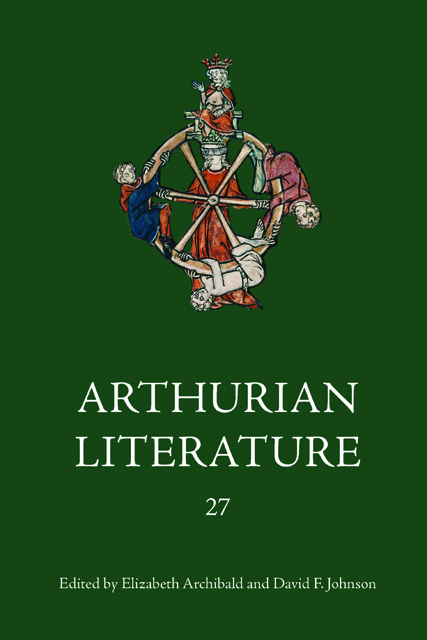Book contents
- Frontmatter
- Contents
- General Editors’ Foreword
- List of contributors
- I Commemoration in La Mort le roi Artu
- II ‘… “if indeed I go”’: Arthur’s Uncertain End in Malory and Tennyson
- III The Intruder at the Feast: Negotiating Boundaries in Medieval Insular Romance
- IV What Women Really Want: The Genesis of Chaucer’s Wife of Bath’s Tale
- V Monstrous Appetite and Belly Laughs: A Reconsideration of the Humour in The Weddyng of Syr Gawen and Dame Ragnell
- VI Speaking (of) Treason in Malory’s Morte Darthur
- VII Lancelot of the Laik: A Scottish Mirror for Princes
- VIII Prince Arthur’s Archers: Innovative Nostalgia in Early Modern Popular Chivalry
- Miscellaneous Endmatter
II - ‘… “if indeed I go”’: Arthur’s Uncertain End in Malory and Tennyson
Published online by Cambridge University Press: 18 February 2023
- Frontmatter
- Contents
- General Editors’ Foreword
- List of contributors
- I Commemoration in La Mort le roi Artu
- II ‘… “if indeed I go”’: Arthur’s Uncertain End in Malory and Tennyson
- III The Intruder at the Feast: Negotiating Boundaries in Medieval Insular Romance
- IV What Women Really Want: The Genesis of Chaucer’s Wife of Bath’s Tale
- V Monstrous Appetite and Belly Laughs: A Reconsideration of the Humour in The Weddyng of Syr Gawen and Dame Ragnell
- VI Speaking (of) Treason in Malory’s Morte Darthur
- VII Lancelot of the Laik: A Scottish Mirror for Princes
- VIII Prince Arthur’s Archers: Innovative Nostalgia in Early Modern Popular Chivalry
- Miscellaneous Endmatter
Summary
From early on, King Arthur's ending presented a problem for Arthurian writers of the Middle Ages. Arthur's warfare abroad, whether in his chronicle march on Rome or romance campaign against Lancelot, is halted by Mordred's rebellion. Thrown from Fortune's wheel, he never fully regains ascendancy and his actual ending in (or after) battle is uncertain, a gap in the record. Geoffrey of Monmouth wrote confusingly that Arthur was ‘mortally wounded’ in his last battle, yet that he was taken to Avalon ‘to have his wounds healed’. The twelfth-century Anglo-Norman poet Wace wrote: ‘Merlin said of Arthur, rightly, that his death would be doubtful. The prophet spoke truly: ever since, people have always doubted it and always will, I think, doubt whether he is dead or alive.’ Such lack of certainty and religious ceremonial seems to have caused some concern for later medieval authors. The Vera Historia de Morte Arthuri, which may have influenced the thirteenth-century Vulgate French Mort le roi Artu in this matter, seems purposely to have supplied new elements that vouched for the king's death, despite the mystery of his actual grave, and that made it a ‘good death’ in medieval terms: Arthur thanks God and the Virgin for victory; he dies penitent in Avalon after receiving the sacraments, wearing a hair shirt and surrounded by bishops.
Sir Thomas Malory's construction of the king's last scene, in his Le Morte Darthur (1469), while much more circumstantial than in the chronicle tradition of Wace, did little to remove doubt and ambivalence. Indeed, Malory, following the Stanzaic Morte Arthure, weakens both the certainty and the religious observance of the ‘French book’, the thirteenth-century Vulgate Cycle Mort Artu, where Arthur confesses his sins to an archbishop before the battle and spends all night after it in prayers for the slain and for himself, and a hermit is quite sure it is Arthur's body in a magnificent tomb which is already inscribed to his renown as a conqueror of twelve kingdoms. The Mort Artu, for all its lamenting of Fortune and predictions of disaster, normalizes the battle of Salisbury by recounting in detail the individual deeds and fates of many knights – Yon, Yvain, Aguisant, Sagremor – in its usual style, whereas Malory creates what is for him an unusually brief, blank impression of general slaughter.
- Type
- Chapter
- Information
- Arthurian Literature XXVII , pp. 19 - 32Publisher: Boydell & BrewerPrint publication year: 2010

